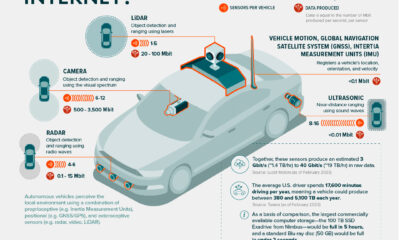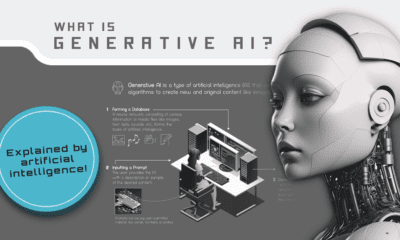But with automakers spending billions to develop the technology—$75 billion by one count—the race is on to be the first to launch a fully self-driving vehicle. This visualization from our sponsor Global X ETFs, takes a look at the drive for a fully autonomous car.
From the Flintstones to the Jetsons
What does it mean to say that a car is autonomous? Does a human driver need to be ready to take over? Can it drive on its own all or just some of the time? And do driving conditions need to be ideal or can it handle the odd thunderstorm? Fortunately, SAE International, the global standards and engineering association, has come up with the creatively-named “Taxonomy and Definitions for Terms Related to On-Road Motor Vehicle Automated Driving Systems,” or SAE JS3016 for short.
The Six Levels of Driving Automation
The system has six levels of automation and spans a yawning gulf of features. Level zero is analogous to Fred Flintstone’s foot-powered, stone age car, while level five is something like George Jetson’s futuristic, bubble-blowing flying saucer.
Level 0: No Driving Automation
The driver is in full control and there is no automation technology. It may include support or alert systems such as stability control and blind-spot warning. Most cars on the road today are level zero.
Level 1: Driver Assistance
The driver is supported by one support system, like adaptive cruise control or lane-following assistance, but needs to be ready to take control at any time.
Level 2: Partial Driving Automation
The driver still needs to be alert and supervise at all times, but the vehicle can take over multiple functions like braking, acceleration, and steering, using Advanced Driving Assistance Systems (ADAS). The Tesla Autopilot feature is generally understood to fall under level two.
Level 3: Conditional Driving Automation
After this point you are not considered to be driving, even if you’re seated in the driver’s seat. Using artificial intelligence (AI), the vehicle handles all driving tasks. A driver still needs to be present in case of an emergency or system failure. Honda’s Traffic Jam Pilot and Mercedes-Benz’s Drive Pilot are the only ones to hit this milestone.
Level 4: High Driving Automation
This is where you lose the steering wheel and pedals. A level four vehicle is completely autonomous, but is limited by speed or to a certain geographic area. In the event of a system failure or emergency, the vehicle can slow down, pull over, and stop on its own. A driverless taxi or public transport would be a likely application at this level.
Level 5: Full Driving Automation
This is the Holy Grail of automated vehicles. At this level, humans are completely superfluous and need only set the destination and sit back and enjoy the ride. The vehicle can drive in any situation, in all conditions, and is not limited to a particular location or speed.
So When Can I Watch Netflix While Driving?
Probably not anytime soon, if figures from California’s Department of Motor Vehicles are any indication. The Pacific state is home to a host of autonomous vehicle manufacturers, many based in Silicon Valley, all eager to test their technology on public roadways. As a result, the DMV has developed regulations for testing self-driving cars, both with and without a driver. Part of the rules require that manufacturers file annual reports about their activities. According to these, at the end of 2021, 26 companies testing 1,174 autonomous vehicles (with a driver) logged over 4 million miles on California roads. By way of comparison, four companies logged only 25,000 miles using driverless vehicles. If you take the miles covered as a proxy for how far the technology has progressed, testing on systems that still require a driver—so level 3 at best—is miles ahead of driverless systems, or level 4 and up.
Hey Siri, Which Way Next?
In addition to being a really tough engineering problem, autonomous cars also raise tricky ethical questions. Part of the difficulty has been trying to get a machine to make the same choices as human drivers would. What if the brakes fail and the AI has to make a split-second decision? Does it swerve to avoid a pedestrian and into a telephone pole, maybe killing the passenger, or keep driving? Problems such as these are often covered in philosophy under the Trolley Problem, which features a runaway trolley and a switch. Throw the switch and save a life, but maybe take another? Tackling this problem, which can get a bit absurd at times, is a good way to discover the “right” answer to ethical questions. Autonomous car manufacturers are going to have to have an answer in any autonomous future.
Invest in the Future of Road Transport
With autonomous car technology advancing at leaps and bounds, there are plenty of opportunities to invest in the companies working to make it a reality. Learn more about the Global X Autonomous & Electric Vehicles ETF (DRIV), which provides exposure to companies involved in the development of autonomous vehicles, EVs, and EV components and materials. You can also learn how experiential technologies like AI are driving change in road transport in Charting Disruption, a joint report by Global X ETFs and the Wall Street Journal (also available as a downloadable PDF). on Today’s connected cars come stocked with as many as 200 onboard sensors, tracking everything from engine temperature to seatbelt status. And all those sensors create reams of data, which will increase exponentially as the autonomous driving revolution gathers pace. With carmakers planning on uploading 50-70% of that data, this has serious implications for policymakers, manufacturers, and local network infrastructure. In this visualization from our sponsor Global X ETFs, we ask the question: will connected cars break the internet?
Data is a Plural Noun
Just how much data could it possibly be? There are lots of estimates out there, from as much as 450 TB per day for robotaxis, to as little as 0.383 TB per hour for a minimally connected car. This visualization adds up the outputs from sensors found in a typical connected car of the future, with at least some self-driving capabilities. The focus is on the kinds of sensors that an automated vehicle might use, because these are the data hogs. Sensors like the one that turns on your check-oil-light probably doesn’t produce that much data. But a 4K camera at 30 frames a second, on the other hand, produces 5.4 TB per hour. All together, you could have somewhere between 1.4 TB and 19 TB per hour. Given that U.S. drivers spend 17,600 minutes driving per year, a vehicle could produce between 380 and 5,100 TB every year. To put that upper range into perspective, the largest commercially available computer storage—the 100 TB SSD Exadrive from Nimbus—would be full in 5 hours. A standard Blu-ray disc (50 GB) would be full in under 2 seconds.
Lag is a Drag
The problem is twofold. In the first place, the internet is better at downloading than uploading. And this makes sense when you think about it. How often are you uploading a video, versus downloading or streaming one? Average global mobile download speeds were 30.78 MB/s in July 2022, against 8.55 MB/s for uploads. Fixed broadband is much higher of course, but no one is suggesting that you connect really, really long network cables to moving vehicles.
Ultimately, there isn’t enough bandwidth to go around. Consider the types of data traffic that a connected car could produce:
Vehicle-to-vehicle (V2V) Vehicle-to-grid (V2G) Vehicles-to-people (V2P) Vehicles-to-infrastructure (V2I) Vehicles-to-everything (V2E)
The network just won’t be able to handle it.
Moreover, lag needs to be relatively non-existent for roads to be safe. If a traffic camera detects that another car has run a red light and is about to t-bone you, that message needs to get to you right now, not in a few seconds.
Full to the Gunwales
The second problem is storage. Just where is all this data supposed to go? In 2021, total global data storage capacity was 8 zettabytes (ZB) and is set to double to 16 ZB by 2025.
One study predicted that connected cars could be producing up to 10 exabytes per month, a thousand-fold increase over current data volumes.
At that rate, 8 ZB will be full in 2.2 years, which seems like a long time until you consider that we still need a place to put the rest of our data too.
At the Bleeding Edge
Fortunately, not all of that data needs to be uploaded. As already noted, automakers are only interested in uploading some of that. Also, privacy legislation in some jurisdictions may not allow highly personal data, like a car’s exact location, to be shared with manufacturers.
Uploading could also move to off-peak hours to even out demand on network infrastructure. Plug in your EV at the end of the day to charge, and upload data in the evening, when network traffic is down. This would be good for maintenance logs, but less useful for the kind of real-time data discussed above.
For that, Edge Computing could hold the answer. The Automotive Edge Computing Consortium has a plan for a next generation network based on distributed computing on localized networks. Storage and computing resources stay closer to the data source—the connected car—to improve response times and reduce bandwidth loads.
Invest in the Future of Road Transport
By 2030, 95% of new vehicles sold will be connected vehicles, up from 50% today, and companies are racing to meet the challenge, creating investing opportunities.
Learn more about the Global X Autonomous & Electric Vehicles ETF (DRIV). It provides exposure to companies involved in the development of autonomous vehicles, EVs, and EV components and materials.
And be sure to read about how experiential technologies like Edge Computing are driving change in road transport in Charting Disruption. This joint report by Global X ETFs and the Wall Street Journal is also available as a downloadable PDF.












